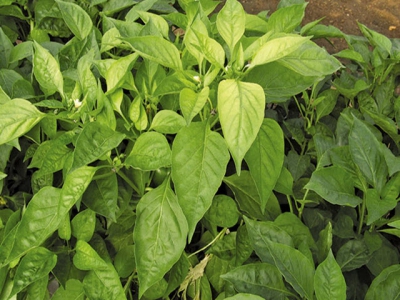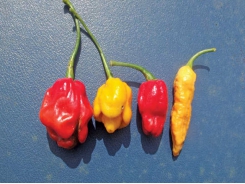Raising capsicum seedlings

Capsicum seedlings need to be treated differently from other kinds of seedling.
Signs of iron deficiency on capsicums. Photo: Bill Kerr
For one thing, capsicums grow more slowly than other seedlings. They are also affected by a high concentration of salt in the irrigation water, whereas other species may be relatively unaffected. Worse, if you carry out frequent, light irrigation, salt will accumulate more easily on the leaf surface. Younger leaves are particularly susceptible and browning will occur along the edges and move inward. Where this is a problem, irrigate less often and during the cool of the day.
Shortage of iron
Capsicum seedlings also frequently suffer from iron deficiency, especially when there is calcium in the water. As the calcium level increases in the soil or growing medium, less iron is available to the plant. One of the symptoms is a yellowing of the leaves. This can easily be confused with a nitrogen shortage. But nitrogen deficiency symptoms are usually first seen on the older leaves, whereas low levels of iron affect the younger leaves.
Iron deficiency also shows as patches in the seedlings because irrigation is never 100% uniform, so calcium will accumulate more quickly in certain areas. Fortunately, a quick and easy solution is available: a foliar spray of iron chelate. If seedlings start showing symptoms at an early stage, one or two more applications may be necessary. The chelate can also be drenched on, but remember, it’s not usually an iron deficiency in the growing medium that causes the problem. Rather, the iron is rendered unavailable due to the calcium increasing the pH. Be careful to apply the foliar feed to the capsicums only, not to other crops.
Successful transplanting
Seedlings should always be grown to suit the conditions present in the plants’ new home. Generally, the softer and more vigorous the seedlings are at transplant, the quicker they will take off – the vigorous growth in the nursery will simply continue in the land. Of course, this presumes that the climatic conditions and aftercare are not too different from the nursery environment. Very often, particularly on the Highveld, growers plant in the land as soon as possible so that they can get into production.
Be extra careful. Late cold fronts, even if not accompanied by frost, can produce winds that can damage the stems.
After such a wind, the stems will be white on the windward side, severely damaging the seedlings. The taller the plants, the worse the damage. Hardened seedlings will withstand cold winds far better. Also, when transplanting into hot conditions, harden the seedlings sufficiently so that they do not experience a setback in the land.
Put another way, while a softer seedling can get off the mark much faster, if there’s any risk of adverse weather or irrigation setbacks, it’s better to err on the side of being too hard than being too soft.
Size makes a difference
The size of the seedlings also plays a role. Remember that the growing medium in the seedling plug stays the same, regardless of the leaf area of the transplant. The smaller the leaf area, the less water is extracted from the plug at transplant, which gives you some leeway. If delays mean that seedlings are taller than ideal, plant them deeper to prevent them from toppling over and the stems from getting sunburnt. The bigger the seedlings, the more frequently they will require light irrigation.
Get it right at the start
Your primary goal should be to ensure a 100% stand with uniformity. Any setback caused by stress at transplanting is likely to manifest throughout the crop’s life. A farmer who rushes to get the crop in very early in spring faces great risk. Even if there are no losses or setbacks, capsicums do not thrive in cool conditions, and you are usually better off waiting until it is safe to plant.
Có thể bạn quan tâm
Phần mềm

Phối trộn thức ăn chăn nuôi

Pha dung dịch thủy canh

Định mức cho tôm ăn

Phối trộn phân bón NPK

Xác định tỷ lệ tôm sống

Chuyển đổi đơn vị phân bón

Xác định công suất sục khí

Chuyển đổi đơn vị tôm

Tính diện tích nhà kính

Tính thể tích ao hồ



 Preparing and planting capsicums
Preparing and planting capsicums  Producing capsicum seedlings in soil beds
Producing capsicum seedlings in soil beds